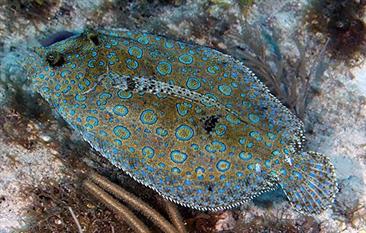





Bothus mancus
| Ecological Descriptors |
||||
| Habitat | Size (cm) | Diet | Behaviour | Sex |
| S, Be | to 45 | Cru, Wor (Pisc), Noct | I | F |
Synonyms:
Flowery Flounder
Description:
Body a deep oval, its depth 54-59% of SL. Distinct notch before lower eye. Lower eye well before upper, with front edge of upper over rear edge of lower. The eyes protrude noticeably, appearing to be raised on short, thick stalks. Mouth small, ending under front half of eye. Brown with numerous variable-sized blue rings and spots on fins and head. (The similar Eyed Flounder, Bothus ocellatus, has brownish ring markings). Three dark blotches along lateral line. The background color can change dramatically to match the bottom. Pectoral fin unusually long, often erect.
Ecology
Lives on sand near coral reefs and reef flats and also found on gravel substrata and mangroves, which is also suitable for the flounders to thrive, as well as within seagrass beds. It feeds on small benthic crustaceans and fishes. This species is commonly observed in shallow water to 10m (30ft), but can be found to 150m (580ft). Enhances its camouflage by partly burying in sand or mud, lying on its blind side, utilising this as a tactic in obtaining their food; unsuspecting prey would approach and as they get close enough, this is when the ambush takes place. Swims over the bottom with a slight wave-like motion.
Life Cycle
The peacock flounder has a life span of up to about 10 years, and breeds serially and year round, usually just before sunset. Their willingness to mate is portrayed by signalling gestures exhibited by both parties. The male shows interest by having erected pectoral fin while the female’s interest is illustrated by the up-down motion of the pectoral fin. The harem mating system allows for a situation where one male mates with several females. Usually the male to female ratio is one to six females found within close proximity to the territory of the male. Mating occurs just before sunset. The male and female interaction begins with the approach, as they meet both their ocular (upper side) pectoral fins are erected, at this point their backs are arched as their snouts touch. Both will then rise in the water column together, which lasts an average of 15 seconds. At the peak of their ascent, both individuals discharge gametes simultaneously. These gametes then form a huge cluster., body
Body a deep oval, its depth 54-59% of SL. Distinct notch before lower eye. Lower eye well before upper, with front edge of upper over rear edge of lower. The eyes protrude noticeably, appearing to be raised on short, thick stalks. Mouth small, ending under front half of eye. Brown with numerous variable-sized blue rings and spots on fins and head. (The similar Eyed Flounder, Bothus ocellatus, has brownish ring markings). Three dark blotches along lateral line. The background color can change dramatically to match the bottom. Pectoral fin unusually long, often erect.
Ecology
Lives on sand near coral reefs and reef flats and also found on gravel substrata and mangroves, which is also suitable for the flounders to thrive, as well as within seagrass beds. It feeds on small benthic crustaceans and fishes. This species is commonly observed in shallow water to 10m (30ft), but can be found to 150m (580ft). Enhances its camouflage by partly burying in sand or mud, lying on its blind side, utilising this as a tactic in obtaining their food; unsuspecting prey would approach and as they get close enough, this is when the ambush takes place. Swims over the bottom with a slight wave-like motion.
Life Cycle
The peacock flounder has a life span of up to about 10 years, and breeds serially and year round, usually just before sunset. Their willingness to mate is portrayed by signalling gestures exhibited by both parties. The male shows interest by having erected pectoral fin while the female’s interest is illustrated by the up-down motion of the pectoral fin. The harem mating system allows for a situation where one male mates with several females. Usually the male to female ratio is one to six females found within close proximity to the territory of the male. Mating occurs just before sunset. The male and female interaction begins with the approach, as they meet both their ocular (upper side) pectoral fins are erected, at this point their backs are arched as their snouts touch. Both will then rise in the water column together, which lasts an average of 15 seconds. At the peak of their ascent, both individuals discharge gametes simultaneously. These gametes then form a huge cluster., body
Peacock Flounder
Peacock Flounder

24



169







